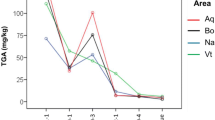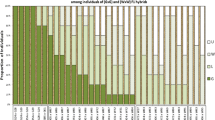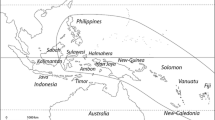Abstract
The glycoalkaloid contents of foliage were measured in populations derived from a cross ofSolanum chacoense Bitter (PI 472810) with a composite sample of genotypes from a randomly matedSolanum tuberosum L. population. The mean total glycoalkaloid contents of the parent PI 472810 andtuberosum populations, and the F2 and F4 populations were 856, 121, 286, and 279 mg/100g fresh weight, respectively. The total glycoalkaloid content of the first backcross population, F2 xtuberosum, was 290 mg/100 g, close to the content of the F2. In a second backcross totuberosum, the mean total content was 148 mg/100 g, close to the content of the parenttuberosum population. Only the glycoalkaloids α-solanine and α-chaconine were found in PI 472810, whereas in the parenttuberosum, hybrid, and backcross populations, the glycoalkaloids α & β-solamarine also were found in a small number of genotypes. The ratios of chaconine to solanine contents were significantly (P≤.05) different in the parent PI 472810 andtuberosum populations, 2.55 and 2.12, respectively. The ratios in the F2 and F4 populations were similar to that of PI 472810, whereas the ratios in the backcross populations were closer to that of thetuberosum parent. The levels of foliage glycoalkaloids in the hybrid and backcross populations paralleled the levels of potato leafhopper,Empoasca fabae Harris, resistance measured in a previous study.
Compendio
Se midieron los contenidos de glicoalcaloides del follaje en poblaciones obtenidas de un cruzamiento de Solanum chacoense Bitter (PI 472810) con una muestra compuesta de genotipos de una población de Solanum tuberosum L. apareada al azar. Los contenidos promedio de gli coalcaloides del progenitor PI 472810, de las poblaciones tuberosum, y de las poblaciones F2 y F4 fueron, respectivamente, 856, 121, 286 y 279 mg/100g de peso fresco. El contenido total de glicoalcaloides de la primera poblacion de retrocruzamiento, F2 x tuberosum, fue 290 mg/g, cercano al contenido de la F2. En un segundo retrocruzamiento a tuberosum, el contenido total promedio fue 148 mg/g, cercano al contenido de la población progenitora tuberosum. Sólo los glicoalcaloides--solanina y--chaconina fueron encontrados en PI 472810, mientras que en las poblaciones progenitoras tuberosum, híbridas y de retrocruzamiento, los glicoalcaloides y β-solamarina fueron también encontrados en un número pequeno de genotipos. Las relaciones de los contenidos de chaconina y solanina fueron significativamente (Ps.05) diferentes en el progenitor PI 472810 y en las poblaciones tuberosum, 2.55 y 2.12, respectivamente. Las relaciones en las poblaciones F2 y F4 fueron similares a la de PI 472810, mientras que las relaciones en las poblaciones de retrocruzamiento fueron cercanas a las del progenitor tuberosum. Los niveles de glicoalcaloides foliares en las poblaciones híbridas y de retrocruzamiento fueron paralelos a los niveles de la cigarrita de la papa, Empoasca fabae Harris, resistencia que fuera medida en un estudio anterior.
Similar content being viewed by others
Literature Cited
Carman, Jr, A.S., S.S. Kuan, G.M. Ware, O.J. Francis, Jr. and G.P. Kirschenheuter. 1986. Rapid high-performance liquid Chromatographic determination of the potato glycoalkaloids α-solanine and α-chaconine. J Agric Food Chem 34:279–282.
Dahlman, D.L. and E.T. Hibbs. 1967. Responses ofEmpoasca fabae (Cicadellidae: Homoptera) to tomatine, solanine, leptine I; tomatidine, solanidine, and demissidine, Ann Entomol Soc Am 60:732–740.
Deahl, K.L., R.J. Young and S.L. Sinden. 1973. A study of the relationship of late blight resistance to glycoalkaloid content in fifteen potato clones. Am Potato J 50:248–253.
Deahl, K.L. and S.L. Sinden. 1987. A technique for the rapid detection of leptine glycoalkaloids in potato foliage. Am Potato J 64:285–291.
Deahl, K.L., S.L. Sinden and R.J. Young. 1993. Evaluation of wild tuberbearingSolarium accessions for foliar glycoalkaloid level and composition. Am Potato J 70:61–69.
Friedman, M., J.R. Rayburn and J.A. Bantle. 1991. Developmental toxicology of potato alkaloids in the frog embryo teratogenesis assayXenopus (FETAX). Food Chem Toxicol 29:537–547.
McCollum, G.D. and S.L. Sinden. 1979. Inheritance study of tuber glycoalkaloids in a wild potato,Solanum chacoense Bitter. Am Potato J 56:95–113.
Raman, K.V., W.M. Tingey and P. Gregory. 1979. Potato glycoalkaloids: effect on survival and feeding behavior of the potato leafhopper. J Econ Entomol 72:337–341.
Ross, H. 1966. The use of wildSolanum species in German potato breeding of the past and today. Am Potato J 43:63–80.
Sanford, L.L., K.L. Deahl, S.L. Sinden and T.L. Ladd, Jr. 1990. Foliar solanidine glycoside levels inSolanum tuberosum populations selected for potato leafhopper resistance. Am Potato J 67:461–466.
Sanford, L.L. and T.L. Ladd, Jr. 1992. Performance of populations derived by selecting for resistance to potato leafhopper in a 4XSolanum tuberosum x 2XSolanum chacoense cross. Am Potato J 69:391–400.
SAS/STAT Guide, Version 6. 1987. SAS Institute Inc., Cary, N.C.
Sinden, S.L. and L.L. Sanford. 1981. Origin and inheritance of solamarine glycoalkaloids in commercial potato cultivars. Am Potato J 58:305–325.
Sinden, S.L., L.L. Sanford and K.L. Deahl. 1986. Segregation of leptine glycoalkaloids inSolanum chacoense Bitter. J Agric Food Chem 34:372–377.
Sinden, S.L., W.W. Cantelo, L.L. Sanford and K.L. Deahl. 1991. Allelochemically mediated host resistance to the Colorado potato beetle,Leptinotarsa decemlineata (Say) (Coleoptera: Chrysomelidae). Mem ent Soc Can 157:19–28.
Sokal, R.R. and F.J. Rohlf. 1969. Biometry. W.H. Freeman and Co., San Francisco, CA. 776 p.
Tingey, W.M., J.D. MacKenzie and P. Gregory. 1978. Total foliar glycoalkaloids and resistance of wild potato species toEmpoasca fabae (Harris). Am Potato J 55:577–585.
Vogel, H., A. Jatisatienr and R. Bauer. 1990. [Quantitative analysis of the glycoalkaloids solasonine and solamargine and their localization in leaves ofSolanum laciniatum Ait.] Angew Botanik 64:393–400.
Author information
Authors and Affiliations
Rights and permissions
About this article
Cite this article
Sanford, L.L., Deahl, K.L. & Sinden, S.L. Glycoalkaloid content in foliage of hybrid and backcross populations from aSolanum tuberosum X S. chacoense cross. American Potato Journal 71, 225–235 (1994). https://doi.org/10.1007/BF02849288
Accepted:
Issue Date:
DOI: https://doi.org/10.1007/BF02849288




